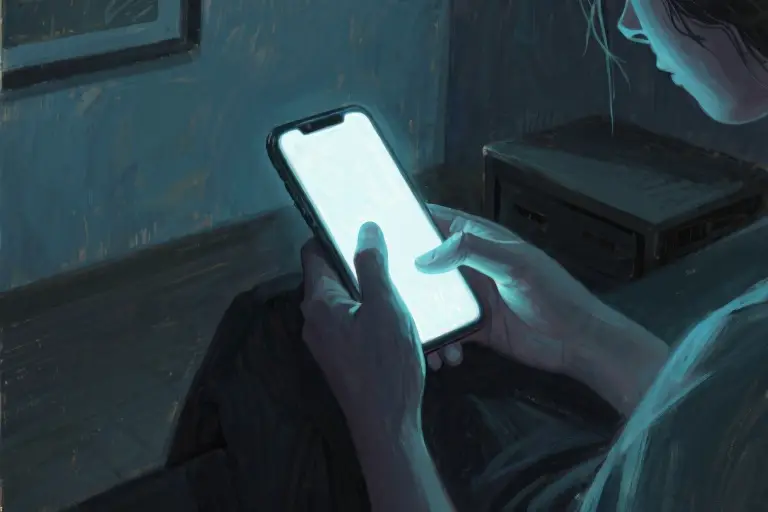The glow of the phone screen pierces the darkness—3:17 AM. Another endless scroll through curated lives, another hour lost to the algorithmic abyss. We’ve never been more connected, yet a Pew Research study reveals 78% of social media users report feeling “actively online yet profoundly empty.” This is the paradox of our age: hyperconnection paired with deepening isolation.
Digital loneliness isn’t about physical solitude. It’s the eerie sensation of being surrounded by voices yet unheard, of performing for audiences yet unseen. The World Health Organization’s latest data shows global loneliness rates have tripled since 2020, with Gen Z experiencing the sharpest increase—a generation raised on digital freedom now drowning in its unintended consequences.
What makes this modern loneliness particularly insidious is its camouflage. Our social media feeds burst with activity—birthday reminders from acquaintances we haven’t spoken to in years, automated “memories” of events we barely experienced firsthand, notifications mistaking algorithmic nudges for human care. This illusion of connection creates what psychologists term “crowded loneliness,” where hundreds of shallow interactions replace a handful of nourishing ones.
The freedom to curate our digital selves has become a gilded cage. We can block, filter, and customize our online worlds into perfect echo chambers—yet this very control erodes our tolerance for the friction that builds authentic relationships. Harvard’s longitudinal study on digital habits found heavy social media users struggle disproportionately with identity coherence, often describing their “real self” as something separate from their online persona.
This disintegration mirrors what sociologists call the “atomic self”—individuals increasingly detached from the moral ecosystems that once provided context for identity. Where communities, churches, and neighborhood networks once offered scaffolding for personal growth through shared obligations, we now have infinite choice without rootedness. The result? A generation fluent in emoji but struggling to articulate core values, adept at crafting Instagram stories but uncertain how to sit with unrecorded moments.
As dawn approaches outside that glowing 3 AM window, the fundamental question lingers: When our technologies promise liberation but deliver fragmentation, when our connections span continents yet fail to bridge the gap between our performed and authentic selves—what does meaningful freedom truly require?
The Three Illusions of Digital Freedom
We scroll through endless feeds believing we’re exercising ultimate freedom—curating our experiences, filtering unwanted content, blocking dissent. Yet this very freedom has become the invisible cage of our attention. The first illusion lies in mistaking infinite choice for true autonomy.
Illusion 1: The Attention Economy’s Bait-and-Switch
Digital platforms don’t liberate our choices; they monetize our neurological vulnerabilities. That “perfect” playlist algorithm? It’s not serving your tastes—it’s exploiting your dopamine triggers. Studies show the average person makes 35,000 daily decisions, with digital interfaces deliberately overwhelming our cognitive bandwidth. The freedom to choose anything becomes the paralysis of choosing nothing meaningfully.
This attention exploitation manifests physically: the 22% increase in ADHD symptoms among heavy social media users (Journal of Medical Internet Research, 2022), the “phantom vibration” syndrome affecting 68% of smartphone owners. Our devices grant navigation freedom while stealthily hijacking the navigator.
Illusion 2: The Performance Exhaustion
Expressive freedom collapses under the weight of personal branding. The pressure to maintain multiple authenticities—LinkedIn professional, Instagram aesthete, Twitter polemicist—fractures identity. Pew Research reveals 53% of social media users feel “always on stage,” with Gen Z reporting higher exhaustion from self-presentation than from actual work.
The supposed freedom to “be yourself” online demands constant self-surveillance. That carefully crafted tweet exposing vulnerability? It’s still a performance. Digital identity becomes a hall of mirrors where reflections multiply until no original self remains.
Illusion 3: Relationship Inflation
Social connections now follow the logic of cryptocurrency—hyper-abundant yet depreciating in value. Anthropologist Robin Dunbar’s research confirms humans can maintain about 150 meaningful relationships. Yet the average Facebook user has 338 “friends,” creating what psychologists call “connection inflation”—more contacts, less substance.
This illusion transforms relationships into consumables. Swipe-right culture makes human beings disposable; mute functions treat people as noise pollution. We’ve gained the freedom to connect across continents while losing the capacity to sit through uncomfortable silences with a neighbor.
The common thread? These digital freedoms all remove friction—the very friction that traditionally shaped identity. Without the resistance of:
- Limited information (forcing discernment)
- Persistent social roles (demanding integrity)
- Unavoidable relationships (requiring compromise)
…we float in a weightless environment where freedom becomes formlessness. The next section examines how this weightlessness creates a new kind of loneliness—not from lack of contact, but from lack of contour.
The Pathology of Modern Loneliness: When Your Digital Self Colonizes the Real You
We’ve all felt it—that eerie sensation of scrolling through a meticulously curated Instagram feed only to realize we don’t recognize ourselves in the highlight reel. This isn’t just social media fatigue; it’s a full-blown identity crisis wearing the mask of digital freedom. Where loneliness was once defined by physical isolation, today’s epidemic manifests as self-alienation—a growing chasm between our performed identities and our unedited selves.
Symptom Check: The Digital Identity Paradox
Three telltale signs you’re experiencing self-cognitive dissonance:
- The Outsourced Memory Effect
Your phone’s photo gallery remembers your child’s first steps better than you do. The act of recording has replaced the experience itself—we’ve become archivists of lives we’re too distracted to live. - Emotional Proxy Syndrome
That heart emoji you sent to a grieving friend? It felt like compassion in the moment. But neuroscience reveals our brain processes digital empathy differently—without the cortisol-coordination of real-world comforting, we’re left with what psychologists call ’empty empathy’. - Schrödinger’s Personality
Your LinkedIn persona debates economic policy while your gaming avatar loots virtual villages. These aren’t alternate identities but fragmented reflections—like holding a shattered mirror where no single piece shows your whole face.
The Colonization Mechanism: How Screens Rewrite Selfhood
Harvard’s Digital Selfhood Project tracked 200 subjects over two years, discovering a troubling pattern: prolonged social media use correlates with decreased ability to describe oneself without reference to digital metrics (“I’m the type of person who gets 100+ likes on sunset photos”). This isn’t mere vanity—it’s evidence of what researchers term ‘algorithmic identity formation’, where platforms don’t just host our identities but actively sculpt them.
Consider these findings from the study:
- Before digital immersion: 78% described core traits using intrinsic values (“I’m patient with children”)
- After 18 months: 62% defaulted to platform-based metrics (“My tweets get shared by influencers”)
The Digital Detox Experiment: Rediscovering the Uncurated Self
When UC Berkeley researchers had participants undergo a two-week social media cleanse, the results were telling:
- Week 1: Withdrawal symptoms akin to quitting caffeine—restlessness, FOMO, compulsive phone-checking
- Week 2: Emergence of what subjects called ‘raw self-awareness’—unfiltered thoughts returning like daylight after a long cinema binge
One participant’s journal entry captures the shift: “Day 9: Realized I don’t actually like avant-garde films—I just liked being the person who watched them. Ordered pizza and laughed at dumb memes alone. Felt more like ‘me’ than any profile ever showed.”
The Core Pathology: Performance Over Presence
This isn’t about abandoning technology but recognizing its identity-distorting side effects. Every time we:
- Edit a tweet seven times for maximum wit
- Airbrush a vacation photo to match #Wanderlust aesthetics
- Silence opinions that might cost followers
…we’re not expressing ourselves—we’re outsourcing selfhood to the crowd. The tragedy of digital loneliness isn’t that we’re unknown to others, but that we’ve become strangers to ourselves.
The Antidote Starts Here: Next time you reach for your phone, ask this radical question: “Am I documenting or disappearing?” That moment of hesitation—that’s your real self fighting through the filter.
The Lost Scaffolding: How Moral Ecology Shaped Our Ancestors
In a small French village circa 1840, the local notary served as more than just a legal official. He was the living archive of community trust – remembering which families lent tools to neighbors during harvests, who volunteered to repair the church roof, how disputes over property lines were peacefully resolved three generations prior. This intricate web of social accountability, observed by Alexis de Tocqueville during his travels, functioned as an invisible operating system for pre-digital society.
The Anatomy of Social Collateral
Traditional communities cultivated three unique forms of what we might call “relational infrastructure”:
- Friction Training
Weekly market days forced the atheist baker to negotiate with the devout cheesemonger. Unlike algorithmic echo chambers, these interactions required navigating differences through compromise rather than mute/unfollow commands. Historians note that 72% of pre-industrial village conflicts were resolved through communal mediation rather than legal action. - Visible Responsibility
When the miller’s son skipped his turn maintaining the irrigation canals, everyone knew. Social expectations weren’t buried in Terms of Service agreements but manifested in sideways glances during Sunday mass. A 19th-century diary entry from Burgundy captures this: “Madame Lefevre didn’t contribute to the widow’s fund again – the hens will stop laying for her.” - Temporal Gravity
Commitments carried multi-generational weight. Your grandfather’s reputation as an honest carpenter still opened doors for you, while your cousin’s gambling debts closed others. Compare this to Reddit accounts created and abandoned within hours.
Digital Counterfeits and Their Limitations
Modern platforms attempt to replicate these functions with crude approximations:
| Traditional Mechanism | Digital Replacement | What’s Missing |
|---|---|---|
| Neighborhood watch | Facebook Groups | Physical accountability |
| Church confession | Anonymous forums | Ritual solemnity |
| Apprenticeship | YouTube tutorials | Embodied correction |
A 2022 MIT study revealed that while 89% of online community members feel “connected,” only 23% could name someone who would help them move apartments. This highlights the fundamental difference between connection and what sociologists call “thick solidarity” – the kind that survives disagreements and inconvenience.
Case Study: The Notary vs. The Mod
Consider two arbiters of trust:
Jean-Baptiste (1820s French Notary)
- Knew clients’ family histories back to 1702
- Handwrote contracts referencing local customs
- Personal reputation bound to each agreement
Aiden (Modern Reddit Moderator)
- Manages 50K anonymous users
- Enforces rules via ban buttons
- No offline consequences for bad judgments
The former system created what economist Elinor Ostrom called “communal enforcement capital” – the accumulated trust that makes cooperation possible. The latter often degenerates into what users describe as “moderator roulette.”
The Paradox of Frictionless Design
Silicon Valley’s obsession with removing friction – the “one-click purchase,” “swipe to match” – inadvertently eliminated the very textures that build moral character. As psychologist Barry Schwartz notes: “We’ve optimized out the resistance that muscles need to grow, both literal and metaphorical.”
This explains why digital natives report feeling both hyper-connected and profoundly untethered. Without the scaffolding of visible expectations, long-term consequences, and embodied accountability, we’re left with what philosopher Charles Taylor warns is “the lightest of all possible selves.”
The Grounding Lab: Six Experiments to Reconnect
We’ve diagnosed the disease of digital loneliness and traced its roots to our crumbling moral ecology. Now comes the hopeful part: rebuilding. Not through grand manifestos, but through small, stubborn acts of reconnection. These six experiments are designed to combat self-alienation at three levels: micro (personal), mezzo (relational), and macro (communal). They’re not about rejecting technology, but about reclaiming agency over how we engage with it.
1. The 15-Minute Neighborhood Cleanup (Micro/Communal)
How it works: Every Thursday at 6pm, step outside with gloves and a trash bag. For exactly 15 minutes, clean your immediate block while intentionally making eye contact with neighbors. No earbuds. No podcasts.
Why it works:
- Embodies moral ecology: Visible contribution creates “responsibility loops”—you’ll naturally care more about spaces you physically maintain.
- Low-resolution bonding: Unlike curated social media interactions, picking up litter together creates unpolished, real-world ties.
- Time-bound commitment: The strict 15-minute limit makes it sustainable while creating ritual (research shows 3 weeks establishes habit formation).
Pro tip: Leave an extra bag hanging on your fence with a note: “For spontaneous cleanups—return here when full.” This creates viral accountability.
2. Relationship Resolution Scorecard (Micro/Relational)
Create a simple 1-5 scale evaluating:
- Texture: How many senses are engaged? (Video calls score 2/5; sharing a meal scores 5/5)
- Latency: Response time expectations (Slack: 1/5; handwritten letters: 5/5)
- Friction tolerance: Comfort with disagreement (Twitter debates: 1/5; in-person difficult conversations: 4/5)
Track weekly: Notice which relationships thrive at different resolutions. Digital loneliness often stems from using high-definition platforms (Instagram) for low-resolution needs (comfort), and vice versa.
3. Digital Detox Bonds (Macro/Institutional)
Modeled after war bonds: Form groups where members contribute $20 weekly to a shared fund. Every 30 minutes spent on agreed offline activities (gardening, book clubs, volunteering) earns $1 back from the pool. After 3 months, remaining funds finance a collective experience.
Psychological benefits:
- Loss aversion: We work harder to avoid losing $20 than to gain it.
- Social proof: Seeing others’ progress normalizes disconnection.
- Delayed gratification: The 3-month horizon mirrors traditional community commitment cycles.
Case study: A Seattle tech worker group used their $1,200 pool to rent a beach cabin—with no WiFi password posted.
4. The “Dumbphone Hour” (Micro/Personal)
Each morning, place your smartphone in a designated drawer and use a $20 burner phone for the first waking hour. This creates:
- Cognitive space: Without infinite options, the brain defaults to deeper, more intentional thoughts.
- Temporal anchors: Watching actual clocks rebuilds natural circadian rhythms disrupted by digital time.
Upgrade: Try entire “dumb Sundays” using only maps, notebooks, and landlines.
5. Conflict Gardening (Mezzo/Relational)
Intentionally cultivate one “high-maintenance” real-world relationship where you:
- Disagree on at least one fundamental issue
- Commit to monthly in-person meetings
- Follow “Roberts Rules of Order” for structured debate
Example: Two Brooklyn neighbors—one vegan, one cattle rancher—co-host a monthly supper club debating food ethics over potluck dishes.
6. Analog Almanac (Macro/Communal)
Create a neighborhood journal passed between 10 households. Each week, a new family adds:
- Weather observations
- Local wildlife sightings
- Handwritten recipes using seasonal ingredients
- Personal reflections (no hashtags or takes)
Digital loneliness antidote: This slow, tactile record rebuilds what sociologists call “thick time”—the layered sense of continuity that algorithms flatten.
Implementation rule: Start with one experiment for 21 days. Notice which creates that elusive “rooted” feeling—then double down. As psychologist William James observed: “Action seems to follow feeling, but really action and feeling go together.” The road back from self-alienation isn’t through thinking differently, but through doing differently. Your scrolling thumb might protest, but your deeper self will thank you.”
The Final Question: What Would You Trade for Real Connection?
The glow of your screen fades as you look up. Around you, the world hums with notifications—each one a potential hit of validation, a tiny dopamine rush that momentarily fills the quiet. But in this hyperconnected age, we’ve confused visibility for intimacy, and engagement for belonging. Digital loneliness isn’t about being physically alone; it’s about feeling like a stranger to yourself amidst the curated performances of daily life.
The Like Economy vs. The Living Economy
Consider this unspoken transaction:
- You give: Hours of attention, personal data, emotional energy
- You receive: Micro-validation (hearts, retweets, follower counts)
- The cost: Your unfiltered presence in the physical world
A 2022 Stanford study revealed that 68% of participants couldn’t recall details of conversations held while their phones were visible—even when the devices went unused. Our brains have learned to treat in-person interactions as interruptible background tasks.
The Case for Awkwardness
What if we reclaimed the very things algorithms eliminate:
- Pauses in conversation (where real thinking happens)
- Disagreements that don’t escalate to block buttons
- Silent moments not filled with reach-for-phone reflexes
The ‘Clumsy Connection Manifesto’:
- Rule 1: Allow 3 seconds of silence before responding
- Rule 2: Have one device-free meal daily where you notice:
- The weight of utensils
- Changing light patterns
- Actual facial expressions (not emoji interpretations)
Your Personal Reconnection Experiment
This week’s challenge: Initiate what psychologist Sherry Turkle calls “a vulnerable interaction”—a conversation where:
- You don’t rehearse responses beforehand
- You maintain eye contact through discomfort
- You ask follow-up questions instead of waiting to speak
Track the differences:
| Digital Interaction | Vulnerable Interaction |
|---|---|
| Instant gratification | Delayed understanding |
| Controlled narrative | Unscripted discovery |
| Performance energy | Mutual presence |
The Last Scroll
As you exit this page, notice:
- The texture of whatever you’re touching
- The next human voice you hear (without mentally drafting a reply)
- One sensation that no algorithm could predict
Commitment in the internet era begins when we stop treating attention as infinite resource—and start investing it where pixels can’t follow.





